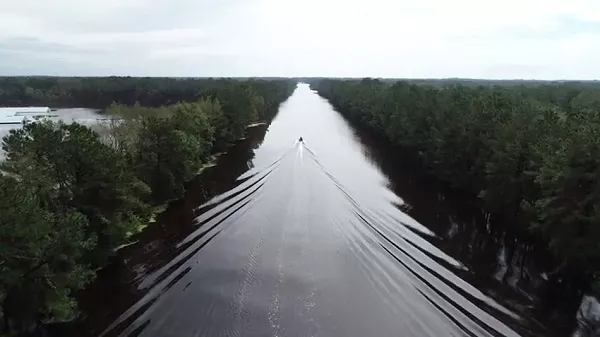By Christian Laspada
Policy Fellow
As we move into the second half of the 2022 hurricane season, the Atlantic region has been spared major storms so far (though we're keeping a close eye on Tropical Storm Fiona). Still, North Carolinians know that the coming months traditionally see the worst weather, and we'll need to stay vigilant.
In every hurricane season, North Carolina’s 300 miles of ocean shoreline and 1,200 miles of coastline along bays and inside the barrier islands are vulnerable to a range of natural hazards: storms, extreme high tides, and strong winds. In more recent years, the danger has grown due to climate change and sea-level rise, and escalating coastal development means more potential for harm.

The 2022 Sea Level Rise Technical Report by the National Oceanic and Atmospheric Administration (NOAA) provides sea-level rise projections through 2150 for U.S. coastal waters. NOAA predicts that within the next 30 years, sea level is expected to rise 10-12 inches on eastern U.S. coasts. Climate change caused by greenhouse emissions could lead to an additional 1.5 to 5 feet of sea-level rise. Researchers at NOAA estimate that, by 2050, Wilmington could see 15 to 65 days of high tide flooding every year.
North Carolina is no stranger to extreme weather events; 52 hurricanes made landfall here between 1851 and 2020. The most recent major hurricane, Florence in 2018, left Wilmington’s roads flooded with as much 23 inches of rain. More than 450 people had to be rescued and over 90% of New Hanover County lost power. The Wilmington area's most destructive hurricane, Hazel, made landfall in 1954. The Category 4 storm killed 19 people and caused more than $135 million in damage.
As any longtime resident can attest, these extreme weather events pose growing threats to people, animals, property, infrastructure, beaches, and coastal wetlands.
During hurricanes, residents often lose power - a problem for any North Carolinian, but particularly disastrous for vulnerable populations, such as low-income communities that are at a disadvantage even in normal weather. Our neighbors in these communities may lose access to emergency services, food, medication and other life-saving resources, and may not be able to afford to relocate to safer places.
The harm can persist long after a storm subsides. Some who were driven from their homes during Hurricane Matthew six years ago are still living in motels, trailers and other temporary quarters due to home construction delays.
Flooding is one of the most common - and expensive - effects of extreme weather, and it can push low-income families below the poverty line. While the best response to a hurricane may be relocation, lower-income residents may not be able to afford to travel and stay somewhere else. Also, these people often aren't salaried workers and can lose income if their employers must shut down.
Protections for these communities should be a top priority as North Carolina's leaders develop coastal resilience and disaster response plans.
The Disaster Relief and Mitigation Act of 2021 was a laudable proposal to help protect North Carolinians from the impacts of extreme weather. Sadly, it stalled out in the state House. But it garnered bipartisan support and can be an example for resiliency legislation in coming years.
The bill would have established a $20 million Disaster Relief and Mitigation Fund to help local governments and nonprofits make communities more resilient to weather disasters. The funds would have been used for flood mitigation efforts, technical support for identification and design of disaster relief projects in vulnerable communities, and matching funds for federal grants.
Natural areas along the coast would have benefited from the Investments in Coastal Properties bill (H 1151), but it, too, was shelved in the most recent General Assembly. This measure would have helped to protect coastal ecosystems by supporting projects such as oyster sanctuaries, living shorelines, and projects to restore wetlands, and reduce agricultural runoff into coastal waters.
There's a standing joke that, if you don't like the weather in North Carolina, just wait a minute - it'll change. But that's no joke for our coastal region as hurricanes, tropical storms, floods and furious winds change for the worse.
North Carolina's leaders must seize the opportunities they have recently shrugged off. They must prioritize legislation and funds to support people, wildlife, homes, businesses, and habitat that face the most harm from the inevitable and increasingly dangerous changes in our weather.